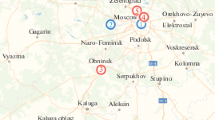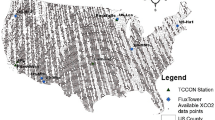Abstract
Based on the data of the Copernicus Atmosphere Monitoring Service reanalysis, the spatial and temporal variations of the CO2 concentration near the surface on the territory of the Russian Federation for the period 2010–2019 were investigated. It was found that the Southwestern part of the country has high values of CO2 concentrations and anthropogenic emissions. However, the growth over 10 years in this area is minimal. The maximum increase is observed in the Far Eastern, Ural, and Siberian federal districts, reaching values of 2.48, 2.41, and 2.39 ppm/year, respectively. In addition, these parts of the Russian Federation have the highest carbon emissions from fires and the highest soil-temperature changes. This change in temperature can lead to a significant release of carbon stored in permafrost. It is possible that these two factors were responsible for the maximum increase in CO2 concentrations in the area over the period 2010–2019. It was found that, in 2016, for the Ural and Volga federal districts, the increase in the average annual CO2 concentration reached 5.8 and 5.65 ppm, and the amplitude value was 31.73 and 26.07 ppm, respectively. This result may be due to a sharp increase in carbon emissions from fires by 310% in the Ural Federal District, as well as a change in soil temperature by about 0.8°C, which in turn may have increased soil emissions in both regions of the Russian Federation. No significant influence of anthropogenic emissions on the change in CO2 concentration is observed. Thus, it can be concluded that the greatest contribution to the increase in the concentration of carbon dioxide over 10 years is due to its natural sources, such as fires, and soil emissions.












Similar content being viewed by others
REFERENCES
WMO Greenhouse Gas Bulletin. The State of Greenhouse Gases in the Atmosphere Based on Global Observations through 2019, No. 16 (23 November 2020).
A. V. Eliseev, “The global CO2 cycle: Main processes and interaction with climate,” Fundam. Prikl. Klimatol., No. 4, 9–31 (2017).
L. Cao, X. Chen, C. Zhang, et al., “The global spatiotemporal distribution of the mid-tropospheric CO2 concentration and analysis of the controlling factors, " Remote Sens. 11 (1), 94 (2019).
M. Yu. Arshinov, B. D. Belan, D. K. Davydov, G. Inouye, Sh. Maksyutov, T. Machida, and A. V. Fofonov, “Vertical distribution of greenhouse gases above Western Siberia by the long-term measurement data,” Atmos. Oceanic Opt. 22 (5), 316–324 (2009).
A. A. Lagutin, E. Yu. Mordvin, and I. A. Shmakov, “Methane content in the troposphere of West Siberia according to AIRS/Aqua data,” Izv. Altai. Gos. Univ., No. 1, 191–196 (2012).
C. L. Parkinson, “Aqua: An Earth-observing satellite mission to examine water and other climate variables,” IEEE Trans. Geosci. Remote Sens. 41 (2), 173–183 (2003).
R. Beer, T. A. Glavich, and T. M. Rider, “Tropospheric emission spectrometer for Earth Observing System’s Aura satellite,” Appl. Opt. 40 (15), 2356–2367 (2001).
T. Yokota, Y. Yoshida, N. Eguchi, et al., “Global concentrations of CO2 and CH4 retrieved from GOSAT: First preliminary results,” Sci. Online Lett. Atmos. 5, 160–163 (2009).
F. Cayla and P. Javelle, “IASI instrument overview,” Opt. Photonics 2553, 1–20 (1995).
J. P. Burrows, E. Hölzle, A. P. H. Goede, et al., “SCIA-MACHY—scanning imaging absorption spectrometer for atmospheric chartography,” Acta Astronaut. 35 (7), 445–451 (1995).
Z. Lv, Y. Shi, S. Zang, and L. Sun, “Spatial and temporal variations of atmospheric CO2 concentration in China and its influencing factors,” Atmosphere 11 (3), 231 (2020).
A. B. Uspensky, A. V. Kukharsky, S. V. Romanov, and A. N. Rublev, “Monitoring the carbon dioxide mixing ratio in the troposphere and the methane total column over Siberia according to the data of the AIRS and IASI IR sounders,” Izv., Atmos. Ocean. Phys. 47 (9) 1097–1103 (2011).
N. M. Gavrilov and Y. M. Timofeev, “Comparisons of satellite (GOSAT) and ground-based spectroscopic measurements of CO2 content near St. Petersburg,” Izv., Atmos. Ocean. Phys. 50 (9), 910–915(2014).
N. V. Rokotyan, R. Imasu, V. I. Zakharov, K. G. Gribanov, and M. Yu. Khamatnurova, “The amplitude of the CO2 seasonal cycle in the atmosphere of the Ural region retrieved from ground-based and satellite near-IR measurements,” Atmos. Oceanic Opt. 28 (1), 49–55 (2015).
D. D. Bokuchava and V. A. Semenov, “Analysis of air surface temperature in the Northern Hemisphere in the 20th century according to observational and reanalysis data,” Fundam. Prikl. Klimatol., No. 1, 28-51 (2018).
D. P. Dee, S. M. Uppala, A. J. Simmons, et al., “The ERA-Interim reanalysis: Configuration and performance of the data assimilation system,” Q. J. R. Meteorol. Soc. 137 (656), 553–597 (2011).
R. Gelaro, W. McCarty, M. J. Suárez, et al., “The modern-era retrospective analysis for research and applications, version 2 (MERRA-2),” J. Clim. 30 (14), 5419–5454 (2017).
S. Kobayashi, Y. Ota, Y. Harada, et al., “The JRA-55 reanalysis: General specifications and basic characteristics,” J. Meteorol. Soc. Jpn. 93 (1), 5–48 (2015).
M. Kanamitsu, W. Ebisuzaki, J. Woolen, et al., “NCEP-DOE AMIP-II reanalysis (R-2),” Bull. Am. Meteorol. Soc. 83 (11), 1631–1643 (2002).
A. Inness, M. Ades, A. Agustí-Panareda, et al., CAMS global reanalysis (EAC4), Copernicus Atmosphere Monitoring Service (CAMS) Atmosphere Data Store (ADS), 2019. https://ads.atmosphere.copernicus.eu/ cdsapp#!/dataset/cams-global-reanalysis-eac4?tab= overview. Accessed December 5, 2019.
European Union, Copernicus Knowledge Base for the Copernicus Climate Change Service and the Copernicus Atmosphere Service, implemented by ECMWF, 2016. http://copernicus-support.ecmwf.int/knowledgebase. Accessed January 20, 2021.
M. Guo, X. Wang, J. Li, et al., “Assessment of global carbon dioxide concentration using MODIS and GOSAT data,” Sensors 12 (12), 16368–16389 (2012).
K. Didan, MOD13C2 MODIS/Terra Vegetation Indices Monthly L3 Global 0.05 Deg CMG V006, 2015, distributed by NASA EOSDIS Land Processes DAAC. https://lpdaac.usgs.gov/products/mod13c2v006/.
A. M. Tarko, A. I. Kurbatova, and E. A. Grigorets, “Application of system analysis methods to studies of forest fires in the Russian Federation, " Geogr. Sreda Zhivye Sist., No. 1, 17–41 (2021).
B. G. Fedorov, Russian Carbon Balance, Moscow: Nauchnyi konsul’tant, 2017 [in Russian].
T. Yokohata, K. Saito, A. Ito, et al., “Future projection of greenhouse gas emissions due to permafrost degradation using a simple numerical scheme with a global land surface model,” Prog. Earth Planet. Sci. 7 (1), 1–14 (2020).
K. Schaefer, H. Lantuit, V. E. Romanovsky, et al., “The impact of the permafrost carbon feedback on global climate,” Environ. Res. Lett. 9 (8), 085003 (2014).
Global Modeling and Assimilation Office (GMAO), MERRA-2 tavgM_2d_lnd_Nx: 2D Monthly Mean Time-Averaged Single-Level Assimilation Land Surface Diagnostics V5.12.4, Greenbelt, Md., Goddard Earth Sciences Data and Information Services Center (GES DISC). https://disc.gsfc.nasa.gov/datasets/ M2TMNXLND_5.12.4/summary. Accessed June 25, 2021.
J. B. Miller, S. J. Lehman, K. R. Verhulst, et al., “Large and seasonally varying biospheric CO2 fluxes in the Los Angeles megacity revealed by atmospheric radiocarbon,” Proc. Natl. Acad. Sci. 117 (43), 26681–26687 (2020).
WMO Greenhouse Gas Bulletin. The State of Greenhouse Gases in the Atmosphere Based on Global Observations through 2016, No. 16 (13 October 2017).
WMO Greenhouse Gas Bulletin. The State of Greenhouse Gases in the Atmosphere Based on Global Observations through 2015, No. 16 (24 October 2016).
T. V. Komarova, Candidate’s Dissertation in Mathematical Physics (Moscow, 2019).
G. V. Frost, M. J. Macander, U. S. Bhatt, et al., “Tundra greenness,” NOAA Arctic Report Card, 2019.
Author information
Authors and Affiliations
Corresponding author
Ethics declarations
The author declares that he has no conflict of interest.
Additional information
Translated by V. Selikhanovich
Rights and permissions
About this article
Cite this article
Dzholumbetov, S.K. Spatial and Temporal Variations in CO2 Concentration in the Surface Atmospheric Layer of the Territory of the Russian Federation Based on the CAMS Database. Izv. Atmos. Ocean. Phys. 58, 158–167 (2022). https://doi.org/10.1134/S0001433822020049
Received:
Revised:
Accepted:
Published:
Issue Date:
DOI: https://doi.org/10.1134/S0001433822020049




